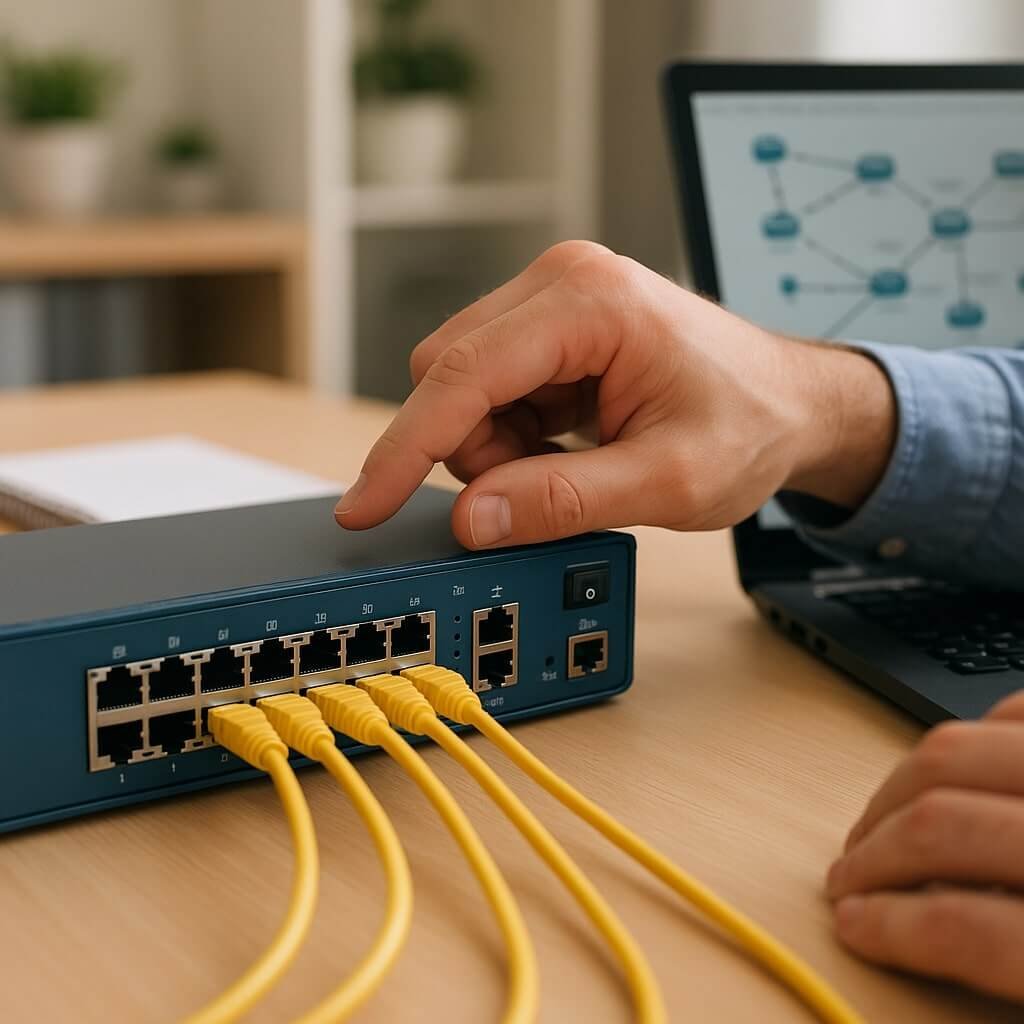Network Security Monitoring (NSM) plays an essential role in your organization’s defense against cyber threats. By continuously analyzing network traffic, it helps you identify suspicious activities that could compromise sensitive data. Understanding NSM’s key components and its significance in real-time threat detection is critical for enhancing your security posture. As you explore this topic further, consider how effective monitoring tools and best practices can fortify your defenses against evolving threats.
Key Takeaways
- Network Security Monitoring acts as a digital watchdog, observing networks for suspicious activities and potential threats in real-time.
- It enhances incident response strategies by quickly identifying and addressing anomalies and unauthorized access attempts.
- Continuous monitoring safeguards sensitive data by detecting malware infections and breaches before they escalate into serious incidents.
- Compliance with data protection regulations is ensured through effective monitoring and security policy enforcement.
- Emerging technologies like AI and machine learning improve monitoring capabilities, enabling proactive threat detection and response.
Understanding Network Security Monitoring
Network security monitoring (NSM) acts as your digital watchdog, constantly observing your network for suspicious activities and potential threats. By analyzing network traffic in real-time, you gain insights into patterns and anomalies that could indicate security breaches.
Implementing robust security protocols is essential; they dictate how data flows and how threats are mitigated. With NSM, you can track unauthorized access attempts, malware infections, and other vulnerabilities that might compromise your system.
This proactive approach not only helps you respond swiftly to incidents but also strengthens your overall security posture. By staying vigilant and utilizing NSM effectively, you can guarantee your network remains resilient against evolving threats, safeguarding your valuable data and resources.
Key Components of Network Security Monitoring
Five key components form the backbone of effective network security monitoring, each playing an essential role in safeguarding your digital environment.
First, network traffic analysis helps you identify anomalies and potential threats by examining data flows in real-time.
Next, security policy enforcement guarantees that your organization adheres to established protocols, reducing vulnerabilities.
Third, intrusion detection systems (IDS) actively monitor for malicious activities, providing alerts when issues arise.
Fourth, log management captures and stores important data for forensic analysis, enabling you to trace incidents effectively.
Finally, incident response plans prepare your team to act swiftly and decisively, minimizing damage when threats are detected.
The Importance of Real-Time Threat Detection
Real-time threat detection is essential for you to identify risks before they escalate into serious breaches.
By proactively monitoring your network, you can minimize the potential damage and enhance your incident response strategies.
This approach not only safeguards your assets but also strengthens your overall security posture.
Proactive Threat Identification
In today’s rapidly evolving digital landscape, proactive threat identification is essential for maintaining robust cybersecurity defenses. By implementing proactive measures, you can stay one step ahead of potential threats within the ever-changing threat landscape.
Real-time detection enables you to identify vulnerabilities before they can be exploited, thereby safeguarding your organization’s assets.
Key components of proactive threat identification include:
- Continuous monitoring: Keeping an eye on network traffic helps you spot anomalies.
- Behavioral analysis: Understanding typical user behavior allows for quicker identification of irregularities.
- Threat intelligence integration: Leveraging external data can enhance your understanding of emerging threats.
Minimizing Damage Impact
Effective proactive threat identification lays the groundwork for minimizing damage impact when incidents occur.
By implementing real-time threat detection, you enable swift damage assessment, allowing your team to quickly evaluate the severity of a breach. This immediate understanding is essential for prioritizing responses and allocating resources effectively.
With timely insights, you can initiate impact mitigation strategies, reducing potential losses and preserving critical assets.
Furthermore, continuous monitoring empowers you to identify patterns and trends, which enhances your overall security posture.
By staying ahead of threats, you not only safeguard your organization but also foster a culture of resilience.
Ultimately, embracing a proactive approach guarantees you’re prepared to address incidents efficiently, minimizing damage impact and securing your operational continuity.
Enhancing Incident Response
As threats evolve and become more sophisticated, having a robust incident response plan that leverages real-time threat detection is essential for any organization.
By implementing this approach, you can greatly enhance your incident analysis and develop effective response strategies.
Consider the following benefits:
- Immediate threat identification: Quickly pinpointing anomalies allows you to address issues before they escalate.
- Informed decision-making: Real-time data enables you to make timely and accurate decisions during incidents.
- Streamlined communication: A well-structured plan guarantees that all stakeholders are informed, facilitating a coordinated response.
Tools and Technologies for Effective Monitoring
While choosing the right tools and technologies for network security monitoring can seem intimidating, having the right resources greatly enhances your ability to detect and respond to threats in real time.
Start by incorporating network analytics tools that provide deep insights into traffic patterns and anomalies. These tools help you analyze vast amounts of data quickly, identifying potential threats before they escalate.
Additionally, utilizing a robust security information and event management (SIEM) system allows you to aggregate and correlate security information from multiple sources. This proactive approach not only streamlines incident detection but also facilitates a more effective response strategy.
Best Practices for Implementing Network Security Monitoring
To successfully implement network security monitoring, you must first establish a clear strategy that aligns with your organizational goals.
Focus on integrating network analysis and threat intelligence to enhance your security posture. Here are some best practices to evaluate:
- Define Clear Objectives: Identify the specific threats you aim to mitigate and how monitoring will support these goals.
- Leverage Automation: Utilize automated tools to streamline data collection and analysis, ensuring timely responses to potential threats.
- Continually Train Your Team: Regularly update your team on the latest threats and monitoring techniques to maintain an effective defense.
Challenges in Network Security Monitoring
Despite the critical importance of network security monitoring, organizations face several significant challenges that can undermine their efforts.
One major hurdle is ensuring data privacy while collecting and analyzing sensitive information. Balancing compliance regulations with effective monitoring can complicate your security strategy, as failing to meet these standards may lead to severe penalties.
Additionally, identifying network anomalies requires advanced threat intelligence, which can be difficult to maintain without proper resources or expertise. As cyber threats evolve, you need to stay ahead of potential risks, making it essential to invest in continuous training and updates for your team.
The Future of Network Security Monitoring
As you consider the future of network security monitoring, it’s vital to recognize how emerging technologies will reshape your approach.
Integrating AI and machine learning will enhance your ability to detect threats in real-time, allowing for quicker response times and more effective defense strategies.
Staying ahead of these advancements is essential for maintaining robust security in an increasingly complex landscape.
Emerging Technologies Integration
While many organizations still rely on traditional methods for network security monitoring, the integration of emerging technologies is revolutionizing how you can safeguard your digital assets.
By leveraging advanced tools, you can enhance your monitoring capabilities and respond to threats more effectively. However, you must also address integration challenges that arise.
- Cloud Computing: Enables scalable resources for real-time monitoring and analysis.
- IoT Devices: Expands your network perimeter, necessitating robust security protocols.
- Blockchain Technology: Offers secure transaction logs, enhancing data integrity and transparency.
Embracing these emerging technologies allows you to strengthen your defenses but requires careful planning to overcome potential integration challenges.
With a proactive approach, you can effectively adapt to the evolving threat landscape.
AI and Machine Learning
AI and machine learning are transforming network security monitoring by enabling organizations to proactively identify and respond to threats with unprecedented speed and accuracy. By leveraging AI applications and machine learning algorithms, you’re empowered to enhance your cybersecurity posture considerably. Predictive analytics helps forecast potential threats, while automated responses minimize human intervention, ensuring quicker mitigation.
Here’s a closer look at these advancements:
| Feature | Description | Benefits |
|---|---|---|
| Threat Intelligence | Real-time data on potential threats | Informed decision-making |
| Behavioral Analysis | Understanding user behavior patterns | Enhanced anomaly detection |
| Data Privacy Protection | Safeguarding sensitive information | Compliance and trust |
These innovations pave the way for a more resilient network environment.
Real-time Threat Detection
Real-time threat detection stands at the forefront of network security monitoring, greatly enhancing an organization’s ability to counteract cyber threats as they emerge. By continuously analyzing network traffic, you can quickly identify and respond to network anomalies, ensuring your defenses remain robust.
Key benefits of real-time threat detection include:
- Immediate identification of threats: Proactively spotting potential breaches allows you to react before damage occurs.
- Adaptive responses: By understanding evolving threat landscapes, your organization can adjust its security posture dynamically.
- Enhanced incident response: Faster recognition of suspicious activities streamlines your incident response process, minimizing downtime.
Incorporating real-time threat detection into your security strategy is essential for safeguarding your organization against increasingly sophisticated cyber threats.
Conclusion
In summary, effective Network Security Monitoring is vital for safeguarding your organization against evolving cyber threats. By continuously analyzing network traffic and implementing best practices, you can enhance your security posture and guarantee rapid incident response. Embracing the right tools and technologies empowers you to detect threats in real-time, protecting sensitive data and maintaining compliance. As the threat landscape evolves, staying proactive in your monitoring efforts will be fundamental to defend against potential breaches and secure your valuable resources.






